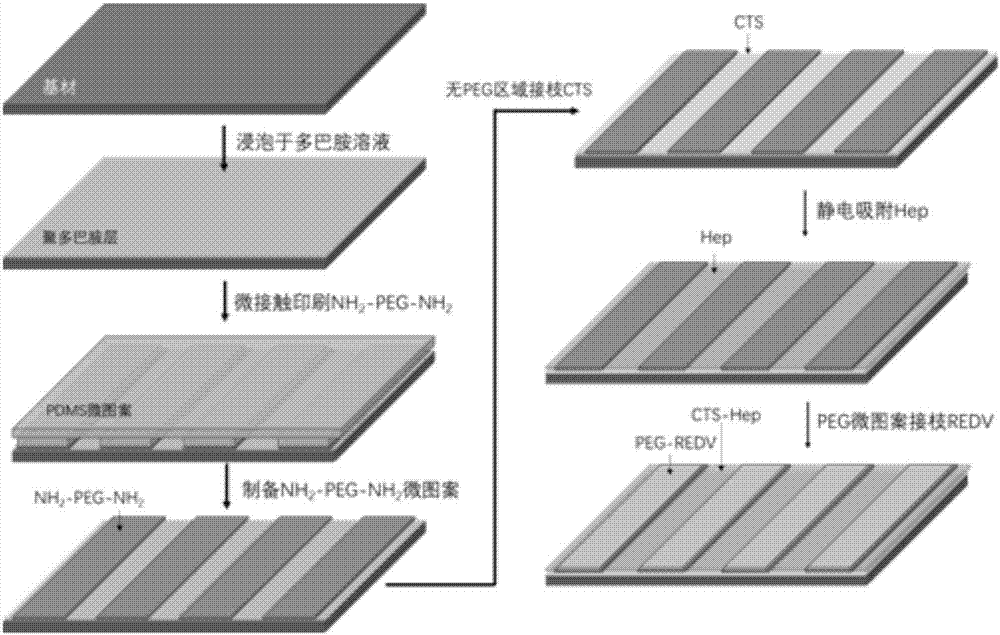Method of building specificity endothelial cell growth promoting anticoagulant surface
A technology of endothelial cells and construction methods, applied in the field of surface modification of biomaterials, can solve the problems of incomplete realization of normal endothelial tissue function, disordered growth of cells, limited anticoagulant performance, etc., and achieve excellent endothelial cell growth-promoting performance, Excellent anticoagulant properties, promoting adhesion and growth effects
- Summary
- Abstract
- Description
- Claims
- Application Information
AI Technical Summary
Problems solved by technology
Method used
Image
Examples
Embodiment 1
[0048] Embodiment 1 prepares the biological material that the width of band and interval are 5 μm
[0049] A method for constructing an anticoagulant surface that specifically promotes endothelial cell growth, specifically comprising the following steps:
[0050] 1) Preparation of polydopamine layer on the surface of biomaterials
[0051] Immerse the biological material in a dopamine solution with a pH of 8.0, fully self-polymerize for 12 hours, wash and dry, repeat three times, the concentration of the dopamine solution is 0.1mg / ml, and obtain the surface of the biological material with a polydopamine layer;
[0052] 2) Microcontact printing immobilization of diaminopolyethylene glycol on the surface of biomaterials
[0053] Add the bis(3-aminopropyl)-terminated polyethylene glycol solution dropwise on the surface of the strip-shaped micropatterned polydimethylsiloxane (PDMS) stamp, and the strip-shaped micropatterned polydimethylsiloxane N2 Dry, then fully contact the PDMS...
Embodiment 2
[0058] Embodiment 2 prepares the biological material that the width of band and interval are 25 μ m
[0059] A method for constructing an anticoagulant surface that specifically promotes endothelial cell growth, specifically comprising the following steps:
[0060] 1) Preparation of polydopamine layer on the surface of biomaterials
[0061] Immerse the biological material in a dopamine solution with a pH of 8.5, fully self-polymerize for 24 hours, wash and dry, repeat three times, the concentration of the dopamine solution is 1 mg / ml, and obtain the surface of the biological material with a polydopamine layer;
[0062] 2) Microcontact printing immobilization of diaminopolyethylene glycol on the surface of biomaterials
[0063] Add the bis(3-aminopropyl)-terminated polyethylene glycol solution dropwise on the surface of the strip-shaped micropatterned polydimethylsiloxane (PDMS) stamp, and the strip-shaped micropatterned polydimethylsiloxane N 2 Dry, then fully contact the P...
Embodiment 3
[0068] Example 3 Preparation of biomaterials with a width and interval of 50 μm of the strips
[0069] A method for constructing an anticoagulant surface that specifically promotes endothelial cell growth, specifically comprising the following steps:
[0070] 1) Preparation of polydopamine layer on the surface of biomaterials
[0071] Immerse the biological material in a dopamine solution with a pH of 8.5, fully self-polymerize for 20 hours, wash and dry, repeat three times, the concentration of the dopamine solution is 0.5 mg / ml, and obtain the surface of the biological material with a polydopamine layer;
[0072] 2) Microcontact printing immobilization of diaminopolyethylene glycol on the surface of biomaterials
[0073] Add the bis(3-aminopropyl)-terminated polyethylene glycol solution dropwise on the surface of the strip-shaped micropatterned polydimethylsiloxane (PDMS) stamp, and the strip-shaped micropatterned polydimethylsiloxane N 2 Dry, then fully contact the PDMS ...
PUM
| Property | Measurement | Unit |
|---|---|---|
| Concentration | aaaaa | aaaaa |
| Concentration | aaaaa | aaaaa |
| Concentration | aaaaa | aaaaa |
Abstract
Description
Claims
Application Information
 Login to View More
Login to View More - R&D
- Intellectual Property
- Life Sciences
- Materials
- Tech Scout
- Unparalleled Data Quality
- Higher Quality Content
- 60% Fewer Hallucinations
Browse by: Latest US Patents, China's latest patents, Technical Efficacy Thesaurus, Application Domain, Technology Topic, Popular Technical Reports.
© 2025 PatSnap. All rights reserved.Legal|Privacy policy|Modern Slavery Act Transparency Statement|Sitemap|About US| Contact US: help@patsnap.com



